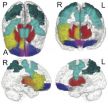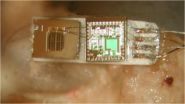(Press-News.org) Why do some teenagers start smoking or experimenting with drugs—while others don't?
In the largest imaging study of the human brain ever conducted—involving 1,896 14-year-olds—scientists have discovered a number of previously unknown networks that go a long way toward an answer.
Robert Whelan and Hugh Garavan of the University of Vermont, along with a large group of international colleagues, report that differences in these networks provide strong evidence that some teenagers are at higher risk for drug and alcohol experimentation—simply because their brains work differently, making them more impulsive.
Their findings are presented in the journal Nature Neuroscience, published online April 29, 2012.
This discovery helps answer a long-standing chicken-or-egg question about whether certain brain patterns come before drug use—or are caused by it.
"The differences in these networks seem to precede drug use," says Garavan, Whelan's colleague in UVM's psychiatry department, who also served as the principal investigator of the Irish component of a large European research project, called IMAGEN, that gathered the data about the teens in the new study.
In a key finding, diminished activity in a network involving the "orbitofrontal cortex" is associated with experimentation with alcohol, cigarettes and illegal drugs in early adolescence.
"These networks are not working as well for some kids as for others," says Whelan, making them more impulsive.
Faced with a choice about smoking or drinking, the 14-year-old with a less functional impulse-regulating network will be more likely to say, "yeah, gimme, gimme, gimme!" says Garavan, "and this other kid is saying, 'no, I'm not going to do that.'"
Testing for lower function in this and other brain networks could, perhaps, be used by researchers someday as "a risk factor or biomarker for potential drug use," Garavan says.
The researchers were also able to show that other newly discovered networks are connected with the symptoms of attention-deficit hyperactivity disorder. These ADHD networks are distinct from those associated with early drug use.
In recent years, there has been controversy and extensive media attention about the possible connection between ADHD and drug abuse. Both ADHD and early drug use are associated with poor inhibitory control—they're problems that plague impulsive people.
But the new research shows that these seemingly related problems are regulated by different networks in the brain—even though both groups of teens can score poorly on tests of their "stop-signal reaction time," a standard measure of overall inhibitory control used in this study and other similar ones. This strengthens the idea that risk of ADHD is not necessarily a full-blown risk for drug use as some recent studies suggest.
The impulsivity networks—connected areas of activity in the brain revealed by increased blood flow—begin to paint a more nuanced portrait of the neurobiology underlying the patchwork of attributes and behaviors that psychologists call impulsivity—as well as the capacity to put brakes on these impulses, a set of skills sometimes called inhibitory control.
Edythe London, Professor of Addiction Studies and Director of the UCLA Laboratory of Molecular Pharmacology, who was not part of the new study, described it as "outstanding," noting that the work by Whelan and others "substantially advances our understanding of the neural circuitry that governs inhibitory control in the adolescent brain."
Using a complex mathematical approach called factor analysis, Whelan and colleagues were able to fish out seven networks involved when impulses were successfully inhibited and six networks involved when inhibition failed—from the vast and chaotic actions of a teenage brain at work. These networks "light up," Whelan says, in a functional MRI scanner during trials when the teenagers were asked to perform a repetitive task that involved pushing a button on a keyboard, but then were able to successfully stop—or inhibit—the act of pushing the button in mid-action. Those teens with better inhibitory control were able to succeed at this task faster.
But the underlying networks behind these tasks could not have been detectable in a "typical fMRI study of about 16 or 20 people," says Whelan. "This study was orders of magnitude bigger, which lets us overcome much of the randomness and noise—and find the brain regions that actually vary together."
"The take-home message is that impulsivity can be decomposed, broken down into different brain regions," says Garavan, "and the functioning of one region is related to ADHD symptoms, while the functioning of other regions is related to drug use.
The new study draws on the multi-year work of the IMAGEN Consortium, funded by the European Union, and headed by Prof. Gunter Schumann at the Institute of Psychiatry, King's College London. IMAGEN, lead by a team of scientists across Europe, carried out neuroimaging, genetic and behavioral analyses in 2000 teenage volunteers in Ireland, England, France, and Germany and will be following them for several years, investigating the roots of risk-taking behavior and mental health in teenagers.
That teenagers push against boundaries—and sometimes take risks—is as predictable as the sunrise. It happens in all cultures and even across all mammal species: adolescence is a time to test limits and develop independence.
But death among teenagers in the industrialized world is largely caused by preventable or self-inflicted accidents that are often launched by impulsive risky behaviors, often associated with alcohol and drug use. Additionally, "addiction in the western world is our number one health problem," says Garavan. "Think about alcohol, cigarettes or harder drugs and all the consequences that has in society for people's health." Understanding brain networks that put some teenagers at higher risk for starting to use them could have large implications for public health.
INFORMATION:
Huge study finds brain networks connected to teen drug abuse
2012-04-30
ELSE PRESS RELEASES FROM THIS DATE:
Single nanomaterial yields many laser colors
2012-04-30
PROVIDENCE, R.I. [Brown University] — Red, green, and blue lasers have become small and cheap enough to find their way into products ranging from BluRay DVD players to fancy pens, but each color is made with different semiconductor materials and by elaborate crystal growth processes. A new prototype technology demonstrates all three of those colors coming from one material. That could open the door to making products, such as high-performance digital displays, that employ a variety of laser colors all at once.
"Today in order to create a laser display with arbitrary colors, ...
2 drugs better than 1 to treat youth with type 2 diabetes
2012-04-30
A combination of two diabetes drugs, metformin and rosiglitazone, was more effective in treating youth with recent-onset type 2 diabetes than metformin alone, a study funded by the National Institutes of Health (NIH) has found. Adding an intensive lifestyle intervention to metformin provided no more benefit than metformin therapy alone.
The study also found that metformin therapy alone was not an effective treatment for many of these youth. In fact, metformin had a much higher failure rate in study participants than has been reported in studies of adults treated with ...
Bioluminescent technology for easy tracking of GMO
2012-04-30
It is important to be able to monitor genetically modified (GM) crops, not only in the field but also during the food processing chain. New research published in BioMed Central's open access journal BMC Biotechnology shows that products from genetically modified crops can be identified at low concentration, using bioluminescent real time reporter (BART) technology and loop mediated isothermal amplification (LAMP). The combination of these techniques was able to recognise 0.1% GM contamination of maize, far below the current EU limit of 0.9%.
In agriculture GM crops have ...
Orangutans harbor ancient primate Alu
2012-04-30
Alu elements infiltrated the ancestral primate genome about 65 million years ago. Once gained an Alu element is rarely lost so comparison of Alu between species can be used to map primate evolution and diversity. New research published in BioMed Central's open access journal Mobile DNA has found a single Alu, which appears to be an ancestral great ape Alu, that has uniquely multiplied within the orangutan genome.
Analysis of DNA sequences has found over a million Alu elements within each primate genome, many of which are species specific: 5,000 are unique to humans, ...
Breastfeeding is associated with a healthy infant gut
2012-04-30
Early colonization of the gut by microbes in infants is critical for development of their intestinal tract and in immune development. A new study, published in BioMed Central's open access journal Genome Biology, shows that differences in bacterial colonization of formula-fed and breast-fed babies leads to changes in the infant's expression of genes involved in the immune system, and in defense against pathogens.
The health of individuals can be influenced by the diversity of microbes colonizing the gut, and microbial colonization can be especially important in regulating ...
A middle-ear microphone
2012-04-30
SALT LAKE CITY, April 30, 2012 – Cochlear implants have restored basic hearing to some 220,000 deaf people, yet a microphone and related electronics must be worn outside the head, raising reliability issues, preventing patients from swimming and creating social stigma.
Now, a University of Utah engineer and colleagues in Ohio have developed a tiny prototype microphone that can be implanted in the middle ear to avoid such problems.
The proof-of-concept device has been successfully tested in the ear canals of four cadavers, the researchers report in a study just published ...
Yellowstone 'super-eruption' less super, more frequent than thought
2012-04-30
PULLMAN, Wash.— The Yellowstone "super-volcano" is a little less super—but more active—than previously thought.
Researchers at Washington State University and the Scottish Universities Environmental Research Centre say the biggest Yellowstone eruption, which created the 2 million year old Huckleberry Ridge deposit, was actually two different eruptions at least 6,000 years apart.
Their results paint a new picture of a more active volcano than previously thought and can help recalibrate the likelihood of another big eruption in the future. Before the researchers split ...
Gladstone scientists identify brain circuitry associated with addictive, depressive behaviors
2012-04-30
SAN FRANCISCO, CA—April 29, 2012—Scientists at the Gladstone Institutes have determined how specific circuitry in the brain controls not only body movement but also motivation and learning, providing new insight into neurodegenerative disorders such as Parkinson's disease—and psychiatric disorders such as addiction and depression.
Previously, researchers in the laboratory of Gladstone Investigator Anatol Kreitzer, PhD, discovered how an imbalance in the activity of a specific category of brain cells is linked to Parkinson's. Now, in a paper published online today in Nature ...
Tablet-based case conferences improve resident learning
2012-04-30
Tablet based conference mirroring is giving residents an up close and personal look at images and making radiology case conferences a more interactive learning experience, a new study shows.
Residents at Northwestern University in Chicago are using tablets and a free screen sharing software during case conferences to see and manipulate the images that are being presented.
"The idea stems from the fact that I was used to having presentation slides directly in front of me during medical school lectures. I thought this would benefit radiology residents, especially in ...
MR enterography is as good or better than standard imaging exams for pediatric Crohn's patients
2012-04-30
MR enterography is superior to CT enterography in diagnosing fibrosis in pediatric patients with Crohn disease and equally as good as CT enterography in detecting active inflammation, and a new study shows.
The study, conducted at Massachusetts General Hospital in Boston, found that MR enterography was 77.6% accurate in depicting fibrosis compared to 56.9% for CT enterography. MR enterography had an 82.1% accuracy rate versus 77.6% accuracy rate for CT enterography for detecting active inflammation, said Keith Quencer, MD, one of the authors of the study. The study ...



